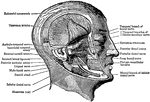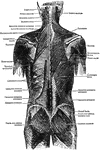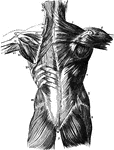The Human Humerus
The human humerus bone, the longest and largest bone of the upper leg. Labels: a, rounded head; gt,…
The Human Ulna and Radius
The Ulna and Radius. Labels: 1, radius; 2, ulna; o, olecranon process, on the anterior surface of which…
Human Femur Bone
The Femur (upper leg bone) is the longest, largest, and strongest bone in the skeleton. Labels: b, rounded…
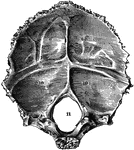
Occipital Bone of the Human Skull
Occipital bone of the human skull, inner surface. It is situated at the back and base of the skull.…

Parietal Bone of the Human Skull
Parietal bone of the human skull, inner surface. The parietal bones form the greater part of the sides…

Frontal Bone of the Human Skull
Frontal bone of the human skull, outer surface. The frontal bone forms the forehead, roof of the orbital…

Temporal Bone of the Human Skull
Temporal bone of the human skull. The temporal bones are situated at the sides and base of the skull.…

Sphenoid Bone of the Human Skull
Sphenoid bone, situated the anterior part of the base of the skull, articulating with all the other…
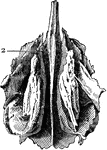
Ethmoid Bone of the Human Skull
Ethmoid bone, posterior surface. The ethmoid bone is an exceedingly light, spongy bone, placed between…

Human Vomer Nasal Bone
Vomer bone, a single bone placed at the back part of the nasal cavity, and forms part of the septum…
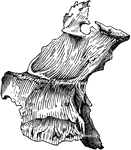
Human Palate Bone
Palate bone. Palate bones form the back part of the roof of the mouth; part of the floor and outer wall…
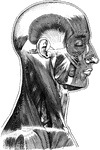
Muscles of Face, Head, and Neck
Muscles of Face, Head, and Neck. Labels: 1, sterno-cleido-mastoid; 10, temporal; 11, masseter; 13, 13,…

Muscles of the Human Back
Muscles of the back. Labels: 50, latissimus dorsi; 51, trapezius; 52, deltoid. The muscles of the back…

Muscles of the Chest and Abdomen
Muscles of the back. Labels: 50, latissimus dorsi; 51, trapezius; 52, deltoid. The muscles of the back…

Heart and Lungs
The heart and lungs. 1, right ventricle; 3, right auricle (atrium); 6, 7, pulmonary artery; 9, aorta;…

Peyer's Patch
Vertical section of a portion of a Peyer's Patch, with lacteal vessels injected. Labels: a, villi, with…

Refrigerating Plant
"In the manufacture of artificial ice, ammonia is liquefied by being compressed by powerful pumps; then…

The Mouth, Nose, and Pharynx
The mouth, nose, and pharynx, with the commencement of gullet (esophagus) and larynx, as exposed by…

The Mouth, Nose, and Pharynx
The mouth, nose, and pharynx, with the larynx and commencement of gullet (esophagus), seen in section.…

Ring Armature
"Ring armature of four pole dynamo; diagram of winding and connections, showing direction of the indced…

Left Eyeball in Horizontal Section
The left eyeball in horizontal section from before back. Labels: 1, sclerotic; 2, junction of sclerotic…

Trunk and Head of Human Body
Diagrammatic longitudinal section of the trunk and head. Labels: 1,1, the dorsal cavity; a, the spinal…
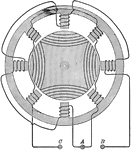
Altenating Current Motor
"...consists of a circular, multipolar field magnet, inclusing a cylinder armature with coils wound…

Reflection of Light
"Thus, if a sunbeam, passing through a small aperure in the window shutter a, be permitted to fall upon…
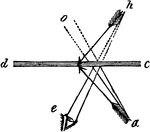
Plane Mirror
"Suppose the arrow a to be the object reflected b the mirror d c; the incident rays a, flowing from…
!["This will be understood [here] where the ray of light A B, proceeding from the eye, falls perpendicularly on the plane mirror B D. will be reflected back in the same line; but the ray C D coming from the feet, which falls obliquely on the mirror, will be reflected back under the same angle in the line D A; and since we see objects in the direction of the reflected rays, and the image appears at the same distance behind the mirror that is object is before it, we must continue the line A D to the feet, E, and for the same reason, the rays A B, from the eye, must be prolonged to F, as far behind the mirror as the line E extends, where the whole image will be represented." -Comstock 1850](https://etc.usf.edu/clipart/35800/35843/mirror3_35843_mth.gif)
Mirror Half the Length of the Object
"This will be understood [here] where the ray of light A B, proceeding from the eye, falls perpendicularly…

Curved Image
"If the object a be placed obliquely before the convex mirror, then the converging rays from its two…
Refracting Telescope
"Suppose the object o to be at such a distance, that the rays of light from it pass in parallel lines,…
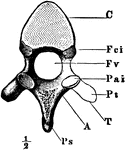
Dorsal Vertebra
The dorsal vertebra seen from behind, i.e. the end turned from the head. Labels: C, the body; A, neural…
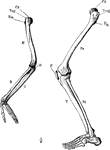
Arm and Leg Skeleton
The skeleton of the arm and leg. Labels: H, the humerus; Cd, its articular head which fits into the…

Sound Refraction
"Fill with carbon dioxide a large rubber toy balloon or other double-convex lens having easily flexible…
Fixed Wave Reflection
"Suport a soft cotton rope several yards long between two fixed supports, as the opposite sides of the…

Explanation of Reflection
"Consider a beam of light as made up of a number of ehter waves moving forward in air and side by side,…

Rays Diverging from Beyond the Center of Curvature on a Concave Mirror
"When the rays diverge form a point at a distance from the mirror less than that of the principal focus,…
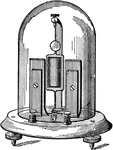
Deprez-d'Arsonval Dead-Beat Reflecting Galvanometer
"In the Deprez-d'Arsonval dead-beat galvanometer, a moveable coil is suspended between the poles of…

Arm Bones
Demonstration of the movement of a pivot joint. Labels: A, arm in supination (palm uppermost); B, arm…
Arm Muscles
The muscles on the back of the hand, forearm, and lower half of the arm, as exposed on dissecting away…
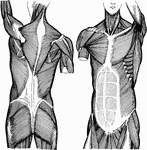
Trunk Muscles
Left - back view of the muscles of the trunk. Right - front view of the muscles of the trunk.

The Mouth, Nose, and Pharynx
The mouth, nose, and pharynx, with the commencement of the gullet (esophagus) and larynx, as exposed…
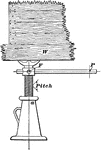
Using a Screw to Raise Weight
"A screw is a cylinder with a helical proection winding around its circumference. This helix is called…
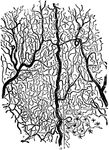
Capillary Network
A small portion of the capillary network as seen in the frog's web when magnified about 25 diameters.…
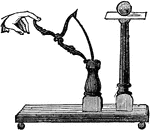
Inertia Demonstration
"On the top of a short pillar is placed a card, and on the card a brass ball. Beside the pillar is fixed…

Compressibility of Air
"Let P be a piston, fitted, air-tight, to the cylinder AB. As the piston is driven down, the air, unable…

Ballistic Pendulum
"From a cross piece, A, on a stout framework, a heavy block of wood, B, is suspended, in such a way…
!["[This illustration] shows a third form of the wheel and axle. Here the axle A is vertical, instead of horizontal. A bar inserted in its head, at the extremity of which the hand is applied, takes the place of the wheel." —Quackenbos 1859](https://etc.usf.edu/clipart/36300/36346/vert_whax_36346_mth.gif)
Vertical Wheel and Axle
"[This illustration] shows a third form of the wheel and axle. Here the axle A is vertical, instead…

Capstan
"The capstan is a familiar example of this form of wheel and axle. It is used by sailors for warping…

Screw and Nut
"Power is applied to the head of the screw. Each time the screw is turned into the nut, it advances…

Right Triangle For Finding Distance Across a River
Right triangle ABC with angles A, B, C to be used for finding distance across a river. This is a trigonometry…
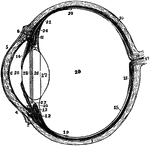
Section of Left Eyeball
The left eyeball in horizontal section from before back. Labels: 1, sclerotic; 2, junction of sclerotic…

Larynx
The larynx viewed from its pharyngeal opening. The back wall of the pharynx has been divided and its…

Muscles on the Back of the Arm, Forearm and Hand
The muscles on the back of the arm, forearm and hand.
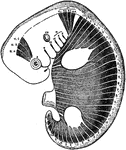
Myotomes in an Embryo
Scheme to illustrate the disposition of the myotomes in the embryo in relation to the head, trunk, and…
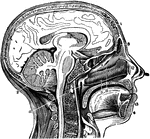
A Vertical Section of the Head and Neck
A vertical section of the head and neck through the mesial line, in order to show the opening of the…
